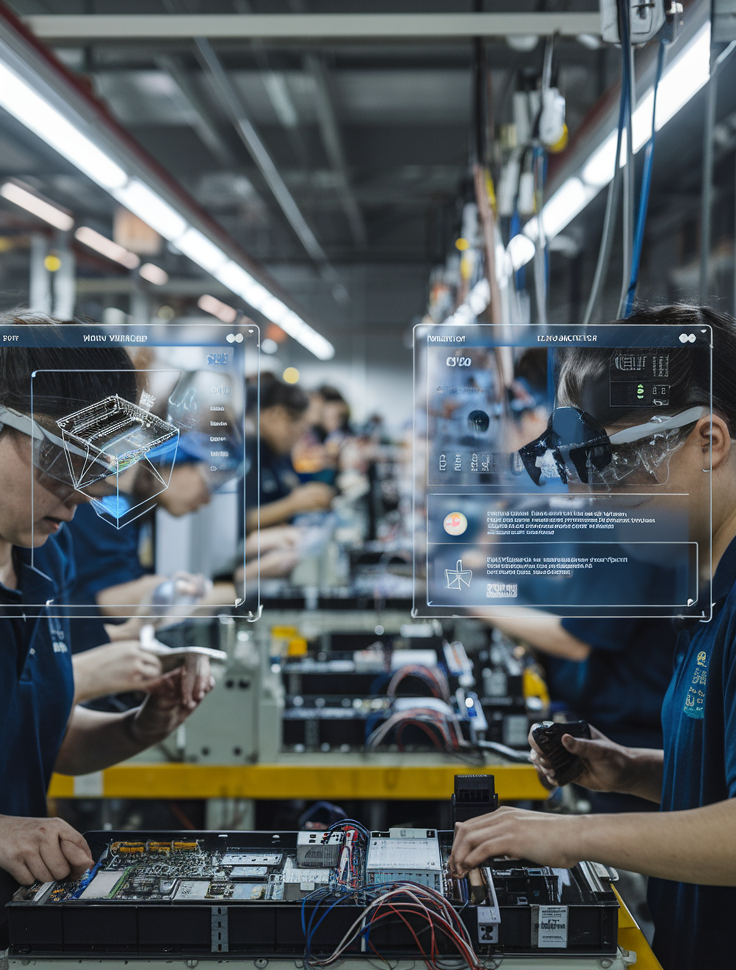Augmented Reality (AR) is revolutionizing the manufacturing industry, transforming the way processes are managed and tasks are performed. By overlaying digital information onto the physical world, AR enables manufacturers to optimize operations, increase productivity, and minimize downtime. This article explores how AR app development and VR training are enhancing efficiency in manufacturing and the benefits they bring to the table.

The Role of AR in Manufacturing
AR technology leverages digital content such as 3D models, animations, and real-time data to provide workers with critical information while performing tasks. With the integration of AR, workers can visualize complex machinery, view step-by-step instructions, and receive real-time guidance, leading to fewer errors and faster problem resolution.
AR development has expanded to include various industrial applications such as maintenance, assembly, quality assurance, and training. When combined with VR training, manufacturers can provide immersive learning experiences, ensuring employees gain practical skills in a controlled virtual environment before they engage with real-world equipment.
Key Ways AR Boosts Manufacturing Efficiency
1. Enhanced Maintenance and Troubleshooting
AR can significantly improve maintenance processes by enabling technicians to view machine data, maintenance history, and troubleshooting guides overlaid onto the actual equipment. Through AR app development, solutions can be designed that allow workers to diagnose and repair equipment more quickly, leading to reduced downtime. This is especially valuable in high-stakes manufacturing environments where delays can have a significant financial impact.
2. Improved Assembly and Production Processes
AR guides can be used to assist workers during complex assembly tasks. Visual instructions overlaid onto the assembly line help ensure each step is performed correctly, reducing the likelihood of errors. As a result, the time taken to assemble products is shortened, and the need for rework is minimized. Furthermore, AR-enabled quality control systems can detect defects or deviations in real time, ensuring that production standards are consistently met.
3.Efficient Training with AR and VR Integration
Combining AR with VR training solutions enhances the learning experience for manufacturing employees. AR allows workers to train on actual equipment with visual aids, while VR immerses them in a simulated environment to practice scenarios that may be hazardous or complex. Together, they provide a comprehensive training solution that accelerates learning curves and improves retention, equipping workers with the skills they need to perform their jobs more safely and efficiently.
4. Remote Assistance and Collaboration
AR app development can facilitate remote support by enabling experts to view equipment through a worker’s AR device and provide real-time guidance. This reduces the need for on-site visits, saving time and travel costs. Additionally, VR-based remote collaboration tools allow teams to work together seamlessly despite being located in different parts of the world, further enhancing productivity and decision-making.
Reducing Downtime with AR
Manufacturers face significant costs when production comes to a halt due to equipment failures or maintenance issues. AR helps minimize downtime by streamlining maintenance, improving troubleshooting accuracy, and enabling faster decision-making. Here are some ways in which AR development reduces downtime:
1. Real-Time Monitoring and Alerts
With AR, equipment can be equipped with sensors that provide real-time performance data. If a machine starts to show signs of wear or deviation from optimal performance, workers receive instant alerts and visual indicators of the problem’s location. This proactive approach to maintenance can help prevent equipment failures before they occur.
2. On-the-Job Guidance and Instructions
AR apps can deliver step-by-step instructions and 3D visualizations directly to workers’ devices. This allows less experienced technicians to perform maintenance tasks they may not be familiar with, as the AR guidance reduces the learning curve and enhances their ability to execute tasks accurately.
3. Predictive Maintenance Integration
AR development can incorporate predictive maintenance strategies that analyze data from sensors to predict when equipment will require servicing. By scheduling maintenance during planned downtimes, manufacturers can avoid unexpected disruptions and keep operations running smoothly.
The Future of AR in Manufacturing
As AR technology continues to evolve, its potential in manufacturing will only expand. With ongoing advancements in AR app development and the integration of AI and IoT, manufacturers can look forward to even more intelligent and adaptive solutions that further boost efficiency and reduce downtime. Combining AR with VR training provides an all-encompassing approach to workforce development, ensuring that employees are better equipped to handle the challenges of modern manufacturing.
Conclusion
AR is driving significant transformations in the manufacturing industry, enabling companies to achieve higher efficiency and reduce downtime. Through AR app development and the integration of VR training, manufacturers can equip their workforce with the tools and skills needed to excel in today’s competitive landscape. Embracing these cutting-edge technologies will not only boost productivity but also position manufacturers at the forefront of innovation, setting the stage for a more resilient and future-ready industry.
By adopting AR solutions now, manufacturers can stay ahead of the curve and reap the long-term benefits of enhanced operational efficiency and reduced downtime. For specialized AR/VR /3D solutions, contact DevDen, an expert AR app development company dedicated to transforming industries with immersive technologies.



